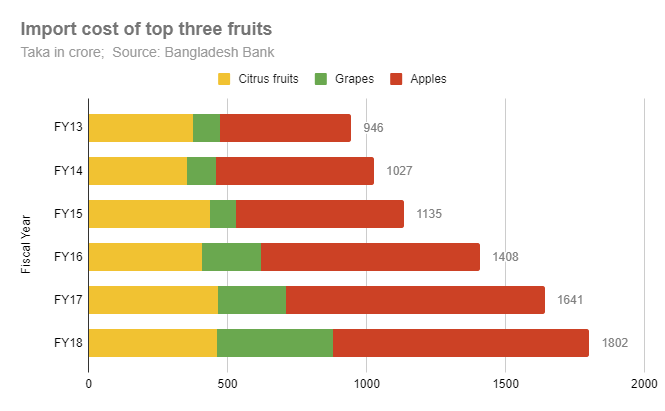Fruits imports soar

A tall glass of chilled vivid purple drink awaits Sarah Hussain as she comes down for breakfast with her family.
Instead of calorific toast or sugary cereals, the first-year student at a local private student prefers to start her day with a healthful fruit smoothie.
“It wakes me up before I set off for classes,” says the health conscious 18-year-old, adding that she attempts to consume five portions of fruits every day.
Like Hussain, many others have upped their consumption of fruits -- compelled by the constant stream of information on the health benefits -- and with it, the import of fruits.
Domestic production of fruit is too insignificant to meet the demand, said Md Serajul Islam, general secretary of Bangladesh Fresh Fruits Importers Association. “And people are consuming more fruits now than in the past,” he said, adding that local production of fruit can meet 30 percent of the annual demand.
Besides, only a certain selection of fruits -- mango, jackfruit, banana, green coconut, guava, pineapple, watermelon and papaya -- are produced in Bangladesh.
And given the growing exposure to the Western world and rising purchasing power, people now demand a wider selection of fruits, according to industry insiders.
Between fiscals 2014-15 and 2018-19, fruit imports have soared 72 percent to 5.99 lakh tonnes, according to data compiled by the Plant Quarantine Wing (PQW) of the Department of Agricultural Extension (DAE), and Bangladesh Bank.
The demand for both imported and locally grown fruits is increasing for changing food habits, increasing population and income, said Md Azhar Ali, director of PQW, which is responsible for regulating the import of plants or plant products to prevent the entry of pests into the country.
“Previously, people were mainly buying fruits when visiting patients. Now, it is quite common to see a bowl of fruit in most dining tables. Health consciousness is rising along with rising income,” Islam said, adding that the demand for fruits is increasing 5 percent annually.
Orange, tangerine, apple and grape represented 85 percent of the fruit imports, according to the PQW.
Citrus fruits like tangerine and orange are grown in the Sylhet region and some parts of the hill tracts in the southeast of Bangladesh, according to the DAE officials. Grapes are also grown.
In fiscal 2016-17, 3,000 tonnes were produced, according to data from the Bangladesh Bureau of Statistics. “We do not have any production of apple, pomegranate and pear,” Islam said, adding that production of non-traditional fruits are on the rise for expanding commercial cultivation.
Production of locally grown fruits has soared but the demand for foreign fruits has increased owing to reluctance among many to consume native fruits, said Chandi Das Kundu, director of horticulture wing of the DAE.
“Many people prefer foreign fruits even though the nutrition value of native fruits is not less than the imported ones. We need to change this mindset,” he added.
But, given the exposure to Western media, Kundu’s department has an uphill task ahead.
“I love a berry smoothie. Berries are so good for you. They are loaded with antioxidants and fibres,” said Hussain as she was gulping down a concoction of imported frozen berries, bananas and coconut water.
